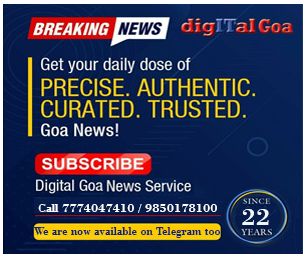July 4- Goa Chamber of Commerce & Industry has submitted a Pre-budget Memorandum on Union Budget 2024-25 to the Union Finance Minister Nirmala Sitharaman. The Memorandum contains fifteen sections which include Macro Level reforms to Direct & Indirect taxes, Rationalisation of Tax rates, Suggestions for Tourism Sector, Real Estate, Shipbuiliding, MSME, Exports, Startups & effective use of IT for Ease of Doing business .Procedural Changes, Processing issues & suggestions relating to Interest & penalties. The Union Budget is likely to be presented in the parliament in the 4th week of July.
PRE-BUDGET MEMORANDUM ON UNION BUDGET: 2024-25
The Goa Chamber of Commerce & Industry has submitted a Pre-budget Memorandum on Union Budget 2024-25 to the Hon’ble Finance Minister Ms Nirmala Sitharaman. The Memorandum sent by GCCI President Mr. Shrinivas Dempo contains fifteen sections which include Macro Level reforms to Direct & Indirect taxes, Rationalisation of Tax rates, Suggestions for Tourism Sector, Real Estate, Shipbuiliding, MSME, Exports, Startups & effective use of IT for Ease of Doing business .Procedural Changes, Processing issues & suggestions relating to Interest & penalties are also a part of the memorandum.
This memorandum has been drafted by the Taxation Committee of GCCI led by CA Rohan Bhandare.
GCCI Director General Mr Sanjay Amonkar has shared some highlights of the budgetary suggestions as under.
1) Incentivising regular Tax payers by faster processing, faster refunds, consider past compliance before issuing notices etc
2) For individual Tax payers raise Standard deduction under new scheme to 25% of the Salary or Rs 1,50,000/- which ever is lower
3) Raise basic limit of Income tax Slab to Rs 5 lakhs
4) Raise rebate under 87A which is now at Rs 7 lakhs to Rs 10 lakhs under new scheme
5) Interest on Housing loan from 2 Lakhs to 5 Lakhs
6) Limits for Gifts Sec 56(2)(x) from Rs 50,000 to Rs 100,000
7) Annual PPF contribution from Rs 1,50,000 to Rs 300,000/-
8) Dividends to be taxed at a flat rate of 5%
9) Deduction limits on FD interest be raised from Rs10,000 to Rs 25,000/-
Some details are as under
- MACRO LEVEL REFORMS- DIRECT TAXES
1. Facility for One Window Registration for New Taxpayers
Difficulty/Issues
Currently, a new business unit is required to submit the same information to multiple state and central agencies to obtain various tax registrations. This eventually leads to duplication of energies, and in turn delays businesses into entering the formal economy.
Recommendation
While only some registrations can be applied together (Eg: CIN and PAN), we suggest that a one window registration option be provided to businesses so that at least the basic registrations, i.e. Permanent Account No. (PAN), TAN, CIN (for Companies/LLPs) and GST registration can be applied for simultaneously. We also suggest that the Centre liaise to onboard the State Departments as well so that local tax licenses can also be obtained simultaneously.
2. Rationalising the TDS&TCS Provisions under the Income Tax Act
Difficulties/Issues Faced:
· Currently there are different types of TDS and TCS with multiple thresholds and different withholding rates.
· There is a possibility of a notice from the Indirect Taxes Department to demand for taxes at a higher rate, based on the wrong category selected by the Deductor while deducting taxes under Income Tax. Such cases were frequent in the service tax era, where deductors incorrectly deducted taxes on the purchase of goods.
Recommendation:
We suggest the following changes:
1. Rationalise the entire TDS and TCS mechanism by consolidating the sections(other than Salary and Non-Residents)into a few major heads for TDS/TCS deductions for resident taxpayers. Example: TDS for Contractors, Commission and Professionals could be combined into one category.
2. The system of TDS compliance should move towards becoming PAN based rather than TAN based.
3. TDS Sections such as 194R, 194Q and 206C(1H), which have resulted in unwarranted complexity in the TDS law should be withdrawn for Ease of Doing Business.
4. The rates for the new TDS sections should not exceed 5%.
5. It is suggested, that a TDS Wallet, similar to banking payments wallet or to an Electronic Cash Ledger in GST may be suitably implemented. This would also give an option to assesses to pay the amount in advance.
6. A detailed notification should be provided by the Income Tax Dept to ensure there are no characterisation disputes.
3. Rationalisation of Capital Gains Provisions
Difficulties/Issues Faced:
Presently the provisions relating to Capital gains, the rates of tax and period of holding of different types of capital assets are very complex and tedious. For example, there are different tax rates for equity and debt instruments, based on its periodicity of holding as well as based on its listing through an exchange. Further, there are different surcharge rates based on the income.
Recommendation:
The Chamber recommends that the Capital Gains provisions are simplified with lesser number of asset classes ( say 2 to 3 asset classes only), with the period of holding being 1 to 2 years for the respective asset classes. The rates of the long term capital gains could be in the range of 10% to 15% for such asset classes.
4. Incentivising Genuine and CompliantIncome Tax & GSTTaxpayers
Recommendation
With many taxpayers having a good compliance history under various tax laws, we believe that identifying and rewarding genuine and regular filers with small benefits will go a long way in not only acknowledging the taxpayers in nation building, but will also encourage others to complete their compliances. While the Income Department had started an initiative of certificates for tax filing, the Chamber suggests that more qualitative benefits could be provided based on internal parameters. We suggest to use the data available with the Direct and Indirect Tax departments to provide benefits to compliant taxpayers such as:
A. Faster Processing of Income Tax Returns
B. Faster Issuances of Refunds under Income Tax Law.
C. Faster Processing ofRefunds under GST for Export and Inverted Duty cases.
D. Considering past compliance history of the taxpayers before issuing any automated tax notices.
E. In case of GST, considering GST compliances in other states where businesses are registered for quicker processing of new branch registrations.
- MACRO LEVEL REFORMS- INDIRECT TAXES
5. Rate Rationalisation for Simplifying GST
We congratulate the Government for completing 7 years of Goods and Services Tax and the record GST monthly collections that reflect the robust economic growth. With a wide base of GST registrations, technological upgradations in GSTN and record GST collections, it is the right time to rationalise the rates and slabs of GST to reduce the tax burden, correct inverted duty structures and avoid cascading effects of taxes. Reducing and simplifying rates will also avoid classification disputes, and conflicting rulings at various foras. The rationalisation of GST rates would also need to be reviewed vis-a-vis the “blocked” credits in GST as well as the existing state taxes, which remain unutilised in the value chain and have a cascading effect on the final prices.
6. Taxation of Non-Corporate Tax Payers
A. Individuals
Difficulties/Issues Faced:
Raising of the income tax threshold limits has been a long pending demand of the salaried employees and non-corporate tax payers. A higher income tax threshold will not only alleviate the financial burden of rising household costs but will also boost the economic growth through higher consumption.
While the standard deduction has now been allowed as a deduction under the New Scheme of Taxation, the amount is still insufficient for a common man, considering the high cost of living. Many employees also incur various expenditures, including expenses for upgrading their knowledge, technical skills, courses etc at their own cost.
Recommendation:
A. It is suggested to raise the basic limit of the income tax slab to Rs. 5 lakhs for the old and new tax regime.
B. It is further suggested to raise the rebate u/s 87A which is now available upto an income of Rs. 7 lakhs to Rs. 10 lakhs under the oldas well as new tax regime.
C. We also suggest that the standard deduction under the New Scheme is increased to 25% of Salary with a maximum cap of Rs. 1,50,000.
B. Extending Concessional Rate of Taxes for Manufacturing Companies to 31st March 2026
Difficulties/Issues Faced:
The Concessional tax rate of 15% for new manufacturing companies has been a great step to promote India as the manufacturing capital of the world and attract foreign companies to set up a manufacturing base in India. However, the conditions to avail this benefit have expired on 31st March 2024. This competitive tax rate which has made many countries consider India as their manufacturing hub has to be extended. The extension would in turn help in driving employment and economic activity.
Recommendation:
The pandemic period had not allowed entities to fully reap the benefits of this provision. Further, with India growing at a rapid pace, this is the correct time to extend this provision to 31st March 2026.
7. Revision in Limits for certain exemptions/ deductions:
Certain exemptions/deduction threshold limits need to be revisited in these current times. A list of such items with the existing limits and proposed limits are:
| Provision | Present Limit | Suggested Limits |
| Interest on Housing Loan – Sec. 24 | Rs. 2,00,000 | Rs. 5,00,000 |
| Limit for Gifts in Section 56(2)(x) | Rs.50,000 | Rs. 1,00,000 |
| Annual limit for contribution to PPF | Rs. 1,50,000 | Rs. 3,00,000 |
Alternatively, we also suggest that many of these deductions/exemptions are linked with the cost index so that the amounts are updated say, every 3 years.
Difficulties/Issues Faced:
In many countries, dividend income is taxed at lower rates since profit out of which dividends are paid, are already taxed at the company level. With the recent changes in dividend taxation, resident shareholders can be subject to higher tax liability as per their individual slab rates, which could extend to 30% (plus surcharge and education cess.)
Recommendation:
To reduce the impact of double taxation as well as encourage corporate structure of businesses, the rate of dividend taxation in the hands of resident investors/shareholders may be kept at a flat rate of 10 %.
9. Section 80TTA- Deduction in respect of interest on deposits in savings account
Difficulties/Issues Faced:
Section 80TTA was inserted by the Finance Act, 2012 to provide deduction of up to Rs.10, 000 in the hands of individuals and HUFs in respect of interest on savings account with banks, post offices and cooperative societies carrying on business of banking. However, it is unlikely that salaried individuals would keep their entire savings in a savings bank account, which earns a much lower rate of interest as compared to term deposits.
Recommendation:
Interest on all types of deposits (including fixed deposit interest) may also be included within the scope of section 80TTA. Further, the deduction limit may be raised to Rs. 25,000.
10. Section 54EC: Time limit for investment in specified bonds
Difficulties/Issues Faced:
Time limit for investment in specified bonds is presently 6 months from the date of transfer. In many cases, assesse is not aware about exemption provision and is made aware by his/her tax consultant at the time of filling of ITRs. Extending this time limit up to the due date of filling of ITR shall also bring parity with section 54/54B/54F etc. where assesse is permitted to deposit the money in Capital Gains Account upto the due date of filing of ITR.
Recommendation:
It is suggested to amend section 54EC so that time limit for investment in specified bonds may be allowed up to the due date of filing of ITR instead of 6 months. Further, it is suggested that the said limit of Rs.50 Lakhs may be raised to Rs. 1.50 crore.
11. Seamless GST Credit for Hotel Stay in Other than Registered States
Difficulties/Issues Faced:
As per Section 12(3)(a) and (b) of the IGST Act, 2017, the place of supply of services directly relating to an immovable property (say, renting of immovable property or lodging accommodation) is the location of the immovable property. Thus, all hotels and property owners are charging CGST plus the respective SGST, irrespective of the fact whether the customer is registered in that State or not. Businesses having a registration in one state, and having accommodation expenditure in other states are unable to claim the input tax credit, since the hotels are required to charge the local state CGST and SGST. This restricts the seamless flow of GST and causes an increase in working capital of businesses who are unable to claim input tax credit of business accommodation.
Recommendation:
Section 12(3)(a) and (b) of IGST Act 2017 to be amended to provide that place of supply in case of the said services provided to “registered persons” shall be the location of such person. Hotels should be allowed to charge Integrated Goods and Services Tax (IGST) that will enable seamless availability of credit to all travel agents and tour operators, and will thereby build a sustainable domestic meetings and conventions business within the country.
12. Option to Charge 12% GST with ITC Benefits for Restaurants
Difficulties/Issues Faced:
Under the current GST regime, standalone restaurants are required to charge GST at 5% with no Input Tax Credit. This would imply that the input tax credit would be a cost to the restaurant. A major expense for restaurants in current times is the rent, which carries an 18% tax rate. This ultimately has to be absorbed by the restaurant and stresses the working capital as well as increases the prices of the products.
Recommendation:
Restaurants should be given an option to choose between charging of 5% GST without ITC or charging GST at 12% with ITC benefit.
13. Rationalise GST Rate for Hotel Accommodation to a single rate of 12%
Difficulties/Issues Faced:
Currently rooms priced up to Rs. 7,500 per day attract a GST of 12% and those above Rs. 7,500 a day come under the 18% tax slab.
Recommendation:
To give a boost to the tourism sector and make travel more affordable, we suggest that the GST on all accommodation services should be at a single rate of 12%.
14. Roll Back Proposal for 20% Tax Collection at Source to 1%
Difficulties/Issues Faced:
The Tax Collection at Source is essentially a tracking mechanism and not a primary source of tax collection. Imposing a 20% TCS will not only increase the compliance burden of the authorised dealers, overseas tour package sellers and the remitters but also increase paperwork, as many of these persons will be seeking certificate of no deduction or lower deduction or asking for refund of the tax so collected at source.
Recommendation:
Therefore, we request you to have to roll back the proposals for the increased TCS rate of 20% on overseas travel and other remittances and introduce a lenient rate of 1% for tracking purposes
15. Allowing GST Input Tax Credit to Real Estate Sector
Difficulties/Issues Faced:
Currently, there is a GST of 5 per cent for under-construction residential units and 1% for affordable housing, but without ITC. No GST is charged on completed units. The GST on cement and steel is 28% and 18% respectively and the tax outgo has spiked along with the rise in these commodity prices. Developers are not able to claim tax credits for GST paid on input items, which leads to an escalation in construction costs. Further, it also negates the purpose of GST which was to remove cascading impact of taxes.
Recommendation:
We recommend that Input Tax Credit (ITC) be allowed to reduce tax burden on the developers. This will also enable developers the room to lower end-user prices.
.
- SUGGESTIONS RELATING TO SHIPBUILDING INDUSTRY
16. Inverted Duty Structure For Shipbuilding Industry Causing Working Capital Issue
Difficulties/Issues Faced
One of the major problems in GST faced by shipbuilding industry is the output rate for repairs of ship as well as for sale of new vessel is 5%, whereas the major purchases particularly steel which is a primary input in the shipbuilding industry carries at GST rate of 18%. Due to this there is an inverted duty structure and there is huge working capital blockage.
Recommendation:
The Government could formulate a solution to reduce this working capital blockage either by way of concessional rate on procurement of steel used by industry or any other suitable mechanism which would help ease the working capital crunch.
17. Allowability of Employees’ contribution of ESIC, PF, etc:
Difficulties/Issues Faced:
Currently the Income Tax Law proposes a different tax treatment for employees’ contribution and employers’ contribution towards the ESI and funds. This discrimination leads to litigation in spite of the fact that the amount is paid subsequently by the assesse. An assesse should not penalised by disallowance of the entire employee contribution for the month for a mere delay under the Income Tax Act, as he is already being penalised under the respective employee related Acts.
Recommendation:
Hence, we propose that the income tax law be suitably amended to allow deduction for employees’ contribution to ESIC and PF if paid before the due date of filing of income tax returns.
18. Refrain from making amendments retrospective in nature
Difficulties/Issues Faced:
Some of the recent retrospective tax decisions taken by the Government are as under:
A. The Finance Act 2022 had made amendments relating to disallowance of education cess with a retrospective effect.
B. Finance Act 2021 has amended certain sections relating to Depreciation of Goodwill, Slump Sale and taxation of partnership firms w.e.f. A.Y. 2021-22 i.e. F.Y. 2020-21.
Recommendation:
In light of giving taxpayers a clarity in taxation, any amendments impacting computation of total income and creating additional tax burden on taxpayers by the Budget should be made with prospective effect.
19. Restrict Filing of Additional Forms along with Income Tax Returns for Special Rates/Concessions
Difficulties/Issues Faced:
During the financial year 2022-23, two new audit reports( Form 10B & 10BB) were made effective for Charitable Institutions. Although a detailed audit. The New Form 10B spans into 49 Clauses and 29 Schedules while Form 10BB contains 32 Clauses and 6 Schedules. While many of the clauses contained common information, many Charitable Institutions have received a notice that they have submitted the Form 10B(detailed report) instead of Form 10BB( concise report). Due to this, the Income Tax Department had to introduce an extended facility to the taxpayers to correct any discrepancies.
Recommendation:
The contents and information required in these forms is already present in the Income Tax Return. Having an additional form only leads to duplication and confusion. It is recommended that any additional details required via the Form should be incorporated in the Income Tax Return itself.

















